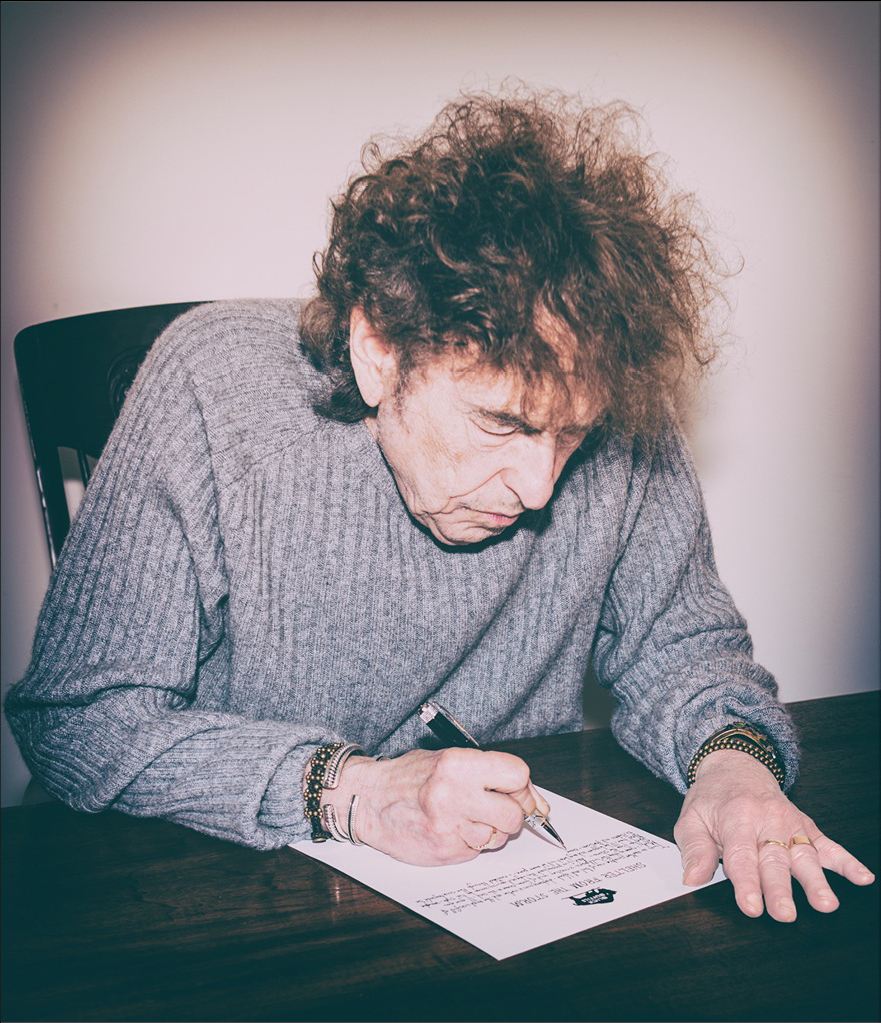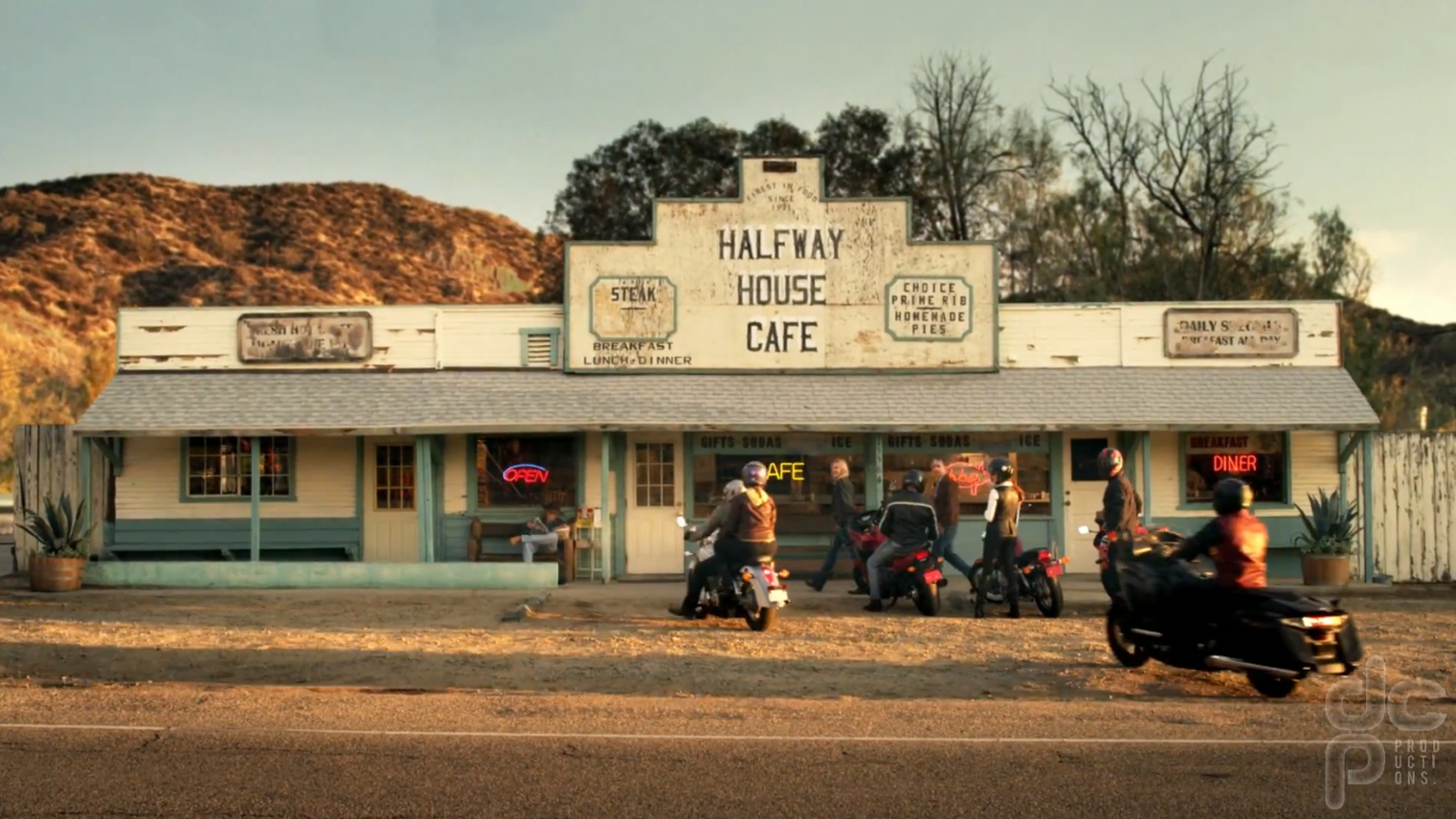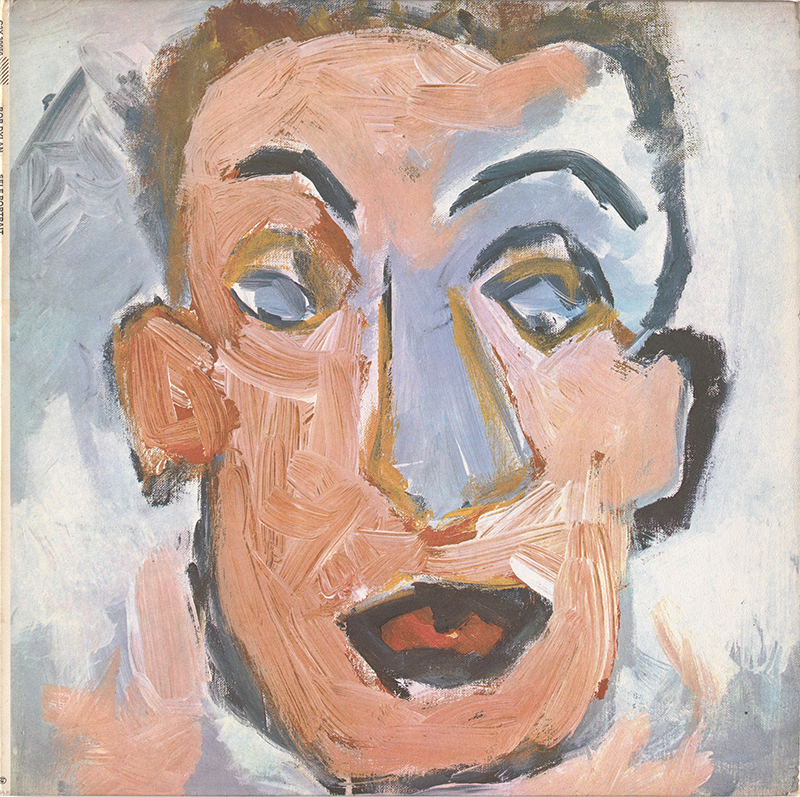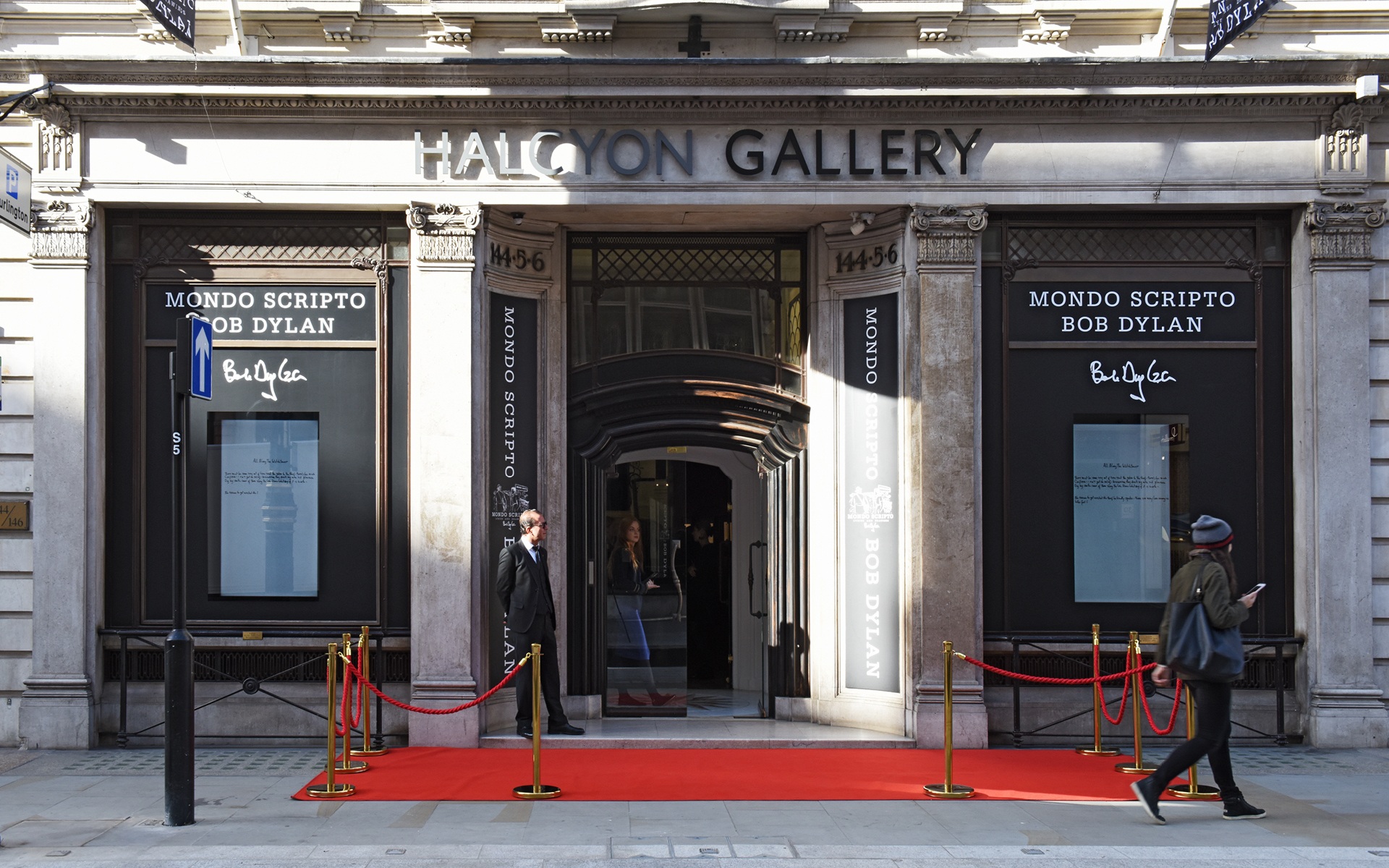|
|

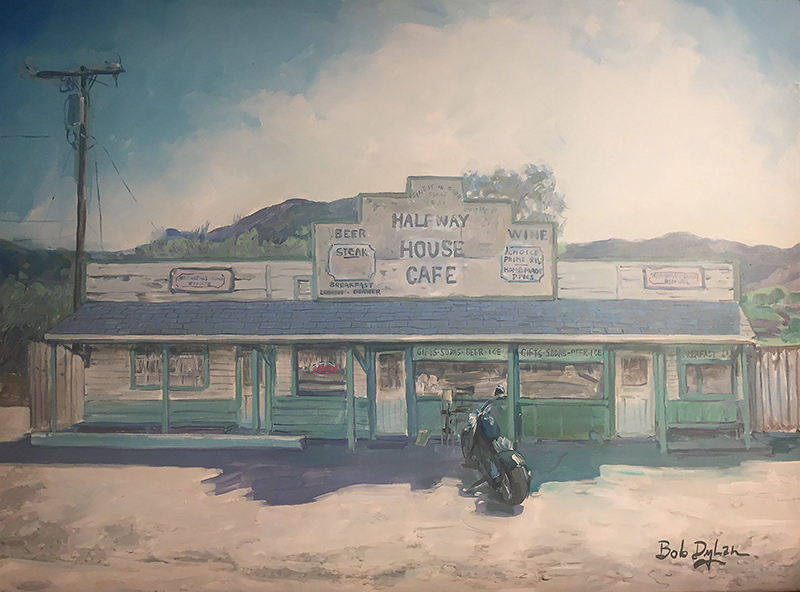
Click image to enlarge
"Santa Clarita Café" by Bob Dylan. (Halfway House Café, 15564 Sierra Highway, Saugus, est. 1931.) Acrylic on canvas, 87 x 122cm (34¼ x 48 in.), 2018. List price: £225,000. Offered by Halcyon Gallery, 144-146 New Bond Street, London.
'The key to the future is in the remnants of the past.' "The idea was to create pictures that would not be misinterpreted or misunderstood by me or anybody else," Bob Dylan writes about the series of paintings he completed, for the most part, in 2016.[1] But as with his music, the enigmatic Nobel laureate singer-songwriter-sculptor-painter-filmmaker-disk jockey-bourbon bottler and all-around American legend leaves specific meanings and interpretations to the beholder. As he once told a reporter who asked him to explain his own lyrics: "I'll let other people decide what they are. The academics, they ought to know. I'm not really qualified. I don't have any opinion."[2]
"He doesn't give too much away as to why he does what he does," said art consultant Amanda Payne of Halcyon Gallery when asked why Dylan chose to paint the historic Halfway House Café in Mint Canyon.[3] "The only person who can answer that question is Bob Dylan." Located in London's Mayfair district, Halcyon Gallery has handled Dylan's paintings for more than a decade. The upscale contemporary art gallery commissioned a series of American landscapes from him that evolved into a 2016 exhibition titled "The Beaten Path." Dylan discusses the subjects he selected for the series in Vanity Fair:
When the Halcyon Gallery brought the idea of me doing American landscapes for an exhibition, all they had to do was say it once. And after a bit of clarification, I took it to heart and ran with it. [...] I chose images because of the meanings they have for me, and patterns can be seen in the repeating images — roads, shacks, piers, automobiles, streets, bayous, railroad tracks, bridges, motels, truck stops, power lines, farmyards, theater marquees, churches, signs and symbols, etc. [...] The common theme of these works having something to do with the American landscape — how you see it while crisscrossing the land and seeing it for what it's worth. Staying out of the mainstream and traveling the back roads, free-born style. I believe that the key to the future is in the remnants of the past. That you have to master the idioms of your own time before you can have any identity in the present tense. Your past begins the day you were born and to disregard it is cheating yourself of who you really are.[4] While Dylan's Halfway House Café painting is part of the Beaten Path series, it was not included in the exhibition, which ran from November 5, 2016, to January 2, 2017, because it did not yet exist. "A couple of paintings had not been completed," Payne said. The Halfway House Café rendering was one of them. Payne said in December 2018 that it was finished "within the last year" — sometime before October 9, 2018, when Dylan's current exhibition opened at Halcyon Gallery. Titled "Mondo Scripto," the new series features Dylan's handwritten lyrics in pen on paper, accompanied by original pencil drawings.
'I usually avoid overcrowded streets.' It is difficult to imagine Bob Dylan painting the Halfway House Café from life. Had he been sitting across the street on highly traveled Sierra Highway for hours, painting en plein air, people would have noticed. It would not have happened. Indeed, Payne said, Dylan often sketches and photographs subjects that strike his interest when he is on the road, then goes home to Malibu and paints them in his studio. "As a rule, I usually avoid overcrowded streets," Dylan told a reporter in 2016. "You can carry a sketchbook anywhere. Watercolors are easy to work with. You can set them up anywhere. The easels and paints are transferable. As far as acrylics and oils, I do them in a barn-like studio or a larger space."[5] "Santa Clarita Café" is acrylic on canvas. Dylan's Beaten Path series includes sketches, watercolors and acrylics, the latter being the medium Dylan prefers, Payne said.
The Halfway House Café is one of Los Angeles County's most popular outdoor filming locations, and it has been so for decades. It even appears in a 2014 Geico Motorcycle Insurance commercial which uses the song, "One Headlight" by Jakob Dylan's band, the Wallflowers, as its soundtrack. Jakob Dylan is one of Bob Dylan's six children. A side-by-side comparison shows that the view of the café in the television commercial was not what the elder Dylan painted from. One: The commercial uses a single camera angle that carefully omits the power pole at left (north). Bob Dylan's painting shows the power pole. Two: The mountains in the background are entirely different. Both mountain backgrounds are factually correct, depending on where the artist or photographer stands. Three: The signage on the building is not the same. "Beer" is advertised in the painting but is air-brushed out of the advertising for vehicle insurance! Four: The set is decorated with potted plants for the commercial that are not present in the painting. It's likelier the artist photographed the diner one day while passing through Mint Canyon. It is located about 35-40 miles from his home, and his own title for the painting, "Santa Clarita Cafe," reveals a certain familiarity with the area. ("Santa Clarita" does not appear on the building, which is in the Santa Clarita Valley but not technically in Santa Clarita. Local old-timers wouldn't call it "Santa Clarita," but Angelenos unaware of the vague municipal boundaries would and do.) Or he might simply have found a different image to work from. He does that, too. Dylan defends his artistic process in Vanity Fair. "Some of these works (in the Beaten Path series) have much complexity of detail. Some are less demanding. In some cases my hand couldn't do what my eye was perceiving." Noting that some of the early masters such as Caravaggio, Van Eyck and Vermeer painted from a projected image, he explains:
The camera obscura was a primitive camera invented in the 1600s which projected an image upside down so the painter could work from it. ... These days you don't have to go to all that trouble. You can use a real camera. I put a 58-mm 0.43x wide-angle conversion lens onto a used Nikon D3300 Af-p on quite a few paintings ... and was able to get the desired effect. If that didn't work, I used a convex Plexiglass RCA 24x20 television screen that can be found in old junk shops and looked at the world through that. On Curry Road in Arizona, I used an old movie frame, and I did that on a couple of different paintings, too. In just as many others I drew it straight on. [...] The method with the particular altered lens was used for fullness of effect. In a lot of the other cases, all I needed was a straight edge, compass, and a T square going on a case-by-case basis without abandoning tradition or adhering to any conventions or aesthetic doctrines.[6] Painting is hardly a new venture for Dylan, and he certainly has not always painted from photographs. His album-cover artwork for 1968's "Music from Big Pink" and 1970's "Self-Portrait" are testament to that.
'The viewer doesn't have to wonder.' Dylan's works for The Beaten Path "show little or no emotion," the artist writes. "The attempt was made to represent reality and images as they are without idealizing them."
I restricted myself to traditional subject matter, viewing nothing as shallow or gaudy. A simple hot-dog stand can have classical features ... whiplash curves, flying buttresses, pointed steeples, arches, and waves. They are all there, reflecting any time period, purposely trying to stay away from dramatic or theatrical lighting effects, bringing naturalism to the forefront.[7] True to the goal, "Santa Clarita Café" is a "picture[] that would not be misinterpreted or misunderstood" by the artist or anybody else. Shadows tell us it is just after sunrise in Mint Canyon, and a soft, whitish cast suggests a morning haze.
"An expert painter is a master in color theory, which means he can turn white into black using a complex value system of colors and hues like a Mark Rothko," Dylan writes. "The Beaten Path ... reflects explorations in color, sometimes using colors that become less pronounced and outlines that become less precise. Other times tipping toward the monochromatic."[8] Motorcycles do park out front most mornings, and the lone bike conveys a sense of solitude that still can be found in Santa Clarita's canyon outskirts if you know where to look. "In every picture the viewer doesn't have to wonder whether it's an actual object or a delusional one," Dylan writes. "If the viewer visited where the picture actually existed, he or she would see the same thing. It is what unites us all."[9] "Santa Clarita Café" is available from Halcyon Gallery for 225,000 British pounds, or about $286,500 US, and if it is not sold soon, you might have to travel to China to see it. "We are organizing a major exhibition (of Dylan's works) in Shanghai next year," Payne said. "It will be a traveling museum." Because it was a later addition, "Santa Clarita Café" does not appear in the 2016 "Beaten Path" book. Nor does it appear in the gallery's current exhibition catalog (because it is not part of the Mondo Scripto series). It is too early to know whether prints will be available, Payne said.
Image of "Santa Clarita Café" by Bob Dylan appears on SCVHistory.com by permission of Halcyon Gallery. See and read more about Dylan's visual artwork in this 2021 exibition guide.
1. "In His Own Words: Why Bob Dylan Paints" by Bob Dylan, Vanity Fair, November 2, 2016. 2. "World exclusive: Bob Dylan - I'll be at the Nobel Prize ceremony... if I can" by Edna Gundersen, The (London) Telegraph, October 29, 2016. 3. Telephone interview with Amanda Payne, December 8, 2018. 4. Dylan, Vanity Fair, ibid. 5. Gunderson, The Telegraph, ibid. 6-9. Dylan, Vanity Fair, ibid.
LW3464: 9600 dpi jpeg from digital image by Craig Jamieson, Cambridge, England.
|
The site owner makes no assertions as to ownership of any original copyrights to digitized images. However, these images are intended for Personal or Research use only. Any other kind of use, including but not limited to commercial or scholarly publication in any medium or format, public exhibition, or use online or in a web site, may be subject to additional restrictions including but not limited to the copyrights held by parties other than the site owner. USERS ARE SOLELY RESPONSIBLE for determining the existence of such rights and for obtaining any permissions and/or paying associated fees necessary for the proposed use.
